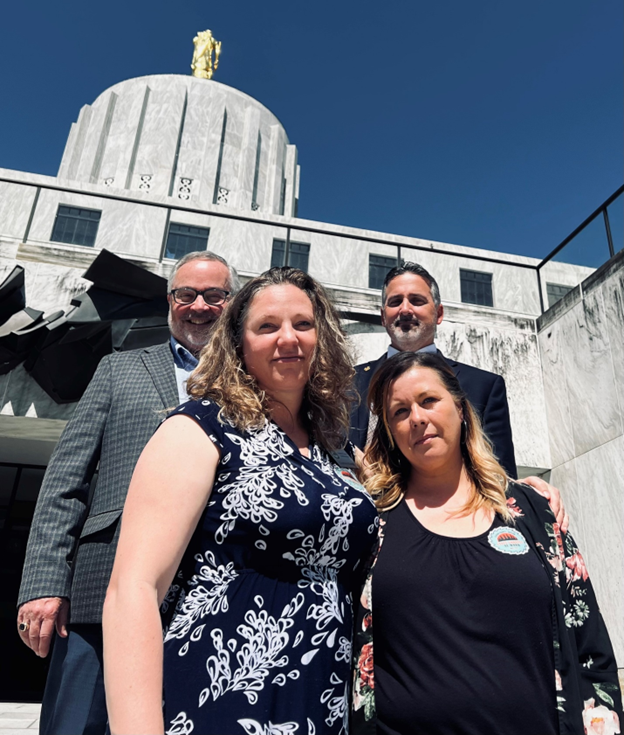Commissioner Courtney Bangs left her home on Oregon’s north coast at 5am on a Tuesday morning. Her destination; the Oregon Capitol. A working mom of three, her position on the Clatsop County Commission is her first experience with public office. “It’s been like drinking from a fire hydrant,” she admits. Bangs’ interest in political life began in 2019 when a cap-and-trade bill was proposed in Oregon that would affect logging, farming, and hauling families in her rural community.
“Everyone who works in forestry and farming got nervous and a bit angry,” she recalls. “It suddenly became clear that the people making the decisions in this state don’t know us, don’t consult us, and don’t value what we do here.” She ran for county office the following year. On this Tuesday in May she travelled to Salem to meet with legislators and advocate for increased accountability and better economic outcomes for Oregon Department of Forestry (ODF) managed forestlands in her county.
Due to a decades old contract with the state, when timber is harvested from state forests, the counties surrounding those forests receive 64% of the revenue. ODF lands make up 26% of the forestland in Clatsop County and support over a thousand jobs as well as critical public services. Bangs’ particular interest over the past several years has been the agency’s proposed 70-year Habitat Conservation Plan (HCP) for state forests. It appears that the HCP will reduce state forest harvests by 60 million board feet a year—a reduction 35% larger than the agency had projected just a few months ago. The lower projection has shocked and alarmed rural residents, schools, fire districts, health providers, the forest sector, and others in the county who depend on state forest harvests for revenue and work. Bangs’ is sharing these concerns throughout the Capitol this day. She checks in with her kids in between meetings with legislators.
ODF is the only state agency that has the ability to fund itself through timber harvest, which it has done for decades, all while supporting public services and jobs in rural communities. While the original twin goals of the HCP were to improve both conservation and financial outcomes for state forests, ODF has acknowledged that if their current draft HCP were implemented as is, the harvest reductions are so significant that the agency would no longer be able to cover its own operating costs.
“ODF was responsible for protecting the financial viability of the agency and the social and economic values of these forests in this HCP process and frankly, they’ve failed,” says Bangs. Part of the problem, according to Bangs, is that the agency doesn’t have a clear understanding of the role state forests play in the local forest economy. “They don’t track or report on the full economic impact of their work—how can they claim to achieve balance if they’re making decisions in the dark?”
On this day in Salem, Commissioner Bangs is also testifying at an informational hearing for HB3585, a bill introduced by Rep. Cyrus Javadi, a freshman legislator from Tillamook. The bill would require that ODF analyze and report annually to the legislature on the economic impacts of its management decisions. While new to the legislature, Javadi has emerged as a passionate advocate for active and responsible state forest management. 50% of the forestland in Tillamook County is managed by ODF. In March, he joined Bangs and upwards of 100 other concerned citizens at a Board of Forestry meeting to urge the Board to take the time needed to develop a less costly HCP. So far, their requests have been denied. The Board of Forestry is currently scheduled to vote on approval of the current draft HCP in September.
HB3585 was co-sponsored by other rural representatives, including former Tillamook mayor, Senator Suzanne Weber. Supporters of the bill, which include Hampton Lumber, hope that by requiring ODF to analyze and report on the full socio-economic impact of its management plans, the agency will be in a position to better balance social, economic, and environmental objectives. It would also provide some accountability and transparency for a process that has been criticized for taking place behind closed doors with little stakeholder engagement.
To the disappointment of many, the bill didn’t get a hearing this year and died in committee. For Javadi, the informational hearing that took place that Tuesday was simply an opportunity to raise a red flag for his colleagues. “This is something we should know about because this will have a massive impact on the socio-economic fabric of Oregon as well as these communities,” he said at the hearing. “If this were to go through, [ODF] will be coming back asking for money in the future biennium, as well as the counties and school districts,” he said.
Oregon’s Governor and legislative leadership have called for increasing school funding and prioritized education, housing, and human services in this year’s budget. But as federal COVID assistance funds run out, state legislators are trying to figure out how to support these priorities with a 2.5% budget reduction. Given such needs throughout the state, Commissioners like Bangs have been left wondering why the state would allow ODF to adopt a plan that would bankrupt the agency and take rural public services down with it.
“This is so avoidable, that’s the most frustrating thing about it,” says Bangs. “I’m not opposed to an HCP. My community isn’t opposed to the concept either. But this HCP is a bad plan that was developed without any meaningful consultation and without anyone looking out for communities.”
Two others joined Bangs in testifying that day in Salem; Kevin Leahy, Director of Clatsop Economic Development Resources (CEDR), and Lindsay Davis of Hampton Family Forests. Kevin advocates for small businesses on the coast and knows better than most how interconnected the forest sector is with the local economy. “These family wage jobs are critical in our rural and underserved community,” said Leahy at the hearing. Economists estimate that 11 jobs are created or retained from harvesting one million board feet. The HCP would reduce current harvests in Clatsop County from 73 MMBF to 48-52 MMBF, which amounts to 231-275 lost jobs. “This will have a devastating impact on the sector, and the small business community, which makes up the majority of employment in Clatsop County,” said Leahy. Forest sector jobs are the backbone of the north coast community and are among the best paying. In Clatsop County, 87% of the land base is forested and off-limits to development, which limits new economic opportunities. The average wage in the forest sector is $77,903, 171% of the average county wage.
Since it was revealed that the HCP would reduce harvests by 35% and decrease funding for local public services, some supporters of the current HCP have pushed for the counties to find new sources of revenue, suggesting that benefiting from timber is an outdated funding model. They talk of “decoupling” state forests from the surrounding counties and supplementing some of that lost revenue with state general fund dollars.
“Some think our deep connection to these forests is a vulnerability,” says Bangs. “We don’t see it that way. We’re proud that we have the capacity and know-how to sustainably grow, harvest, and process wood the region needs. We have no interest in being severed from the natural resources that surround us.” Wood will come from somewhere, she adds, and she’d rather it come from local and sustainably managed forests. “Yes, in my backyard!” she says. “Yes, please!”
Counties and residents most affected by the HCP harvest reductions are also skeptical that the state can make up the difference in lost ODF economic opportunity in their already underserved areas. They point to impacts of similar habitat policies on federal forests in southern Oregon and see trouble on the horizon. Harvests were drastically reduced on 24 million acres of federal forest in the early 1990s to protect Spotted Owl habitat. Mills shuttered across the region. Unfortunately, despite the establishment of these large conservation areas, three decades later Spotted owl populations continue to decline. Federal payments were legislated to try to offset some of the lost revenue, but these payments remain far too little to cover the now limited services in affected regions. Communities continue to struggle in part, because the payments fall short of compensating for the lost jobs and economic activity that is generated by active forest management. Lindsay Davis, who works for Hampton Family Forests in Clatsop County has first-hand experience with this reality. Lindsay, the daughter of a mill worker in Josephine County, Oregon, lived through the shutdown of the federal forests thirty years ago. Her dad and extended family members lost jobs. Some lost hope.
“Almost overnight we went from a family that regularly donated to the food bank to a family that was standing in line at one,” Davis said at the hearing. “The amount of stress, the sadness, tears, watching as your parents worry, watching them argue, wondering if we were all going to be ok – it was maddening at times and certainly traumatic.” Without comparable opportunities outside the forest sector, many in Davis’ community succumbed to disillusion, alcoholism, and drug addiction. “HB 3585 is about better governance for Oregon’s State Forests. It’s about accountability,” says Davis. “The State can and must learn from the federal forest policy mistakes of the past and do better by forest communities like mine.”
When the hearing concluded, those that testified were thanked for their time. They prepare to head home tired but undeterred. Bangs hopes her time in Salem has at least raised some eyebrows in regards to what she believes is a critical but fixable situation. “We care deeply for these forests and the ecosystems and communities they support,” she says. “I can’t believe that state leaders wouldn’t give us an extra year or two to get a better HCP that protects our communities,” she says. “An HCP will be with us for the next 70 years! Let’s take the time to get it right!”


